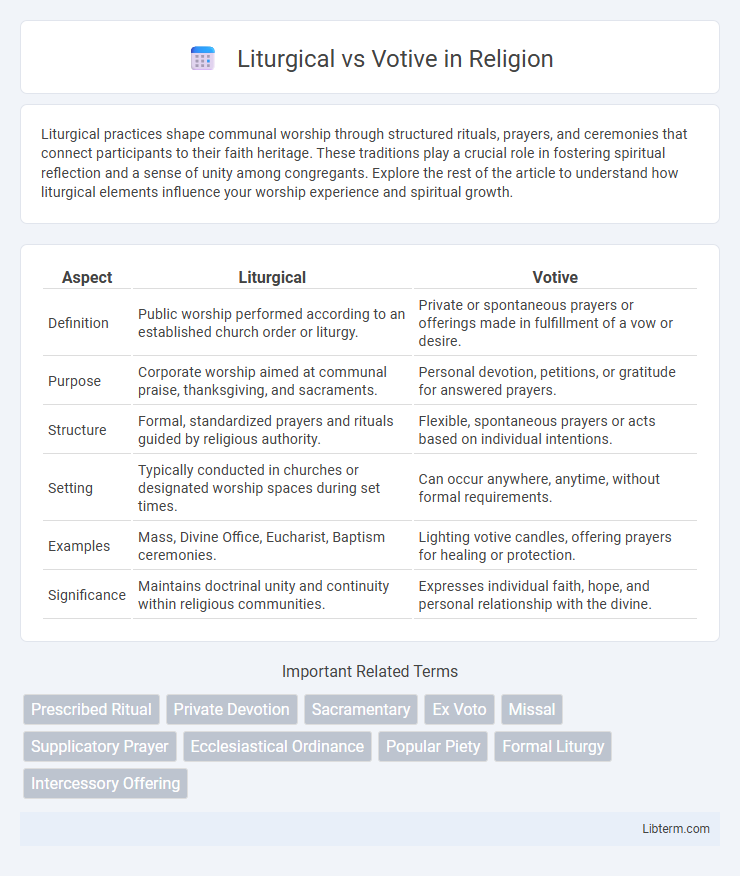Liturgical practices shape communal worship through structured rituals, prayers, and ceremonies that connect participants to their faith heritage. These traditions play a crucial role in fostering spiritual reflection and a sense of unity among congregants. Explore the rest of the article to understand how liturgical elements influence your worship experience and spiritual growth.
Table of Comparison
| Aspect | Liturgical | Votive |
|---|---|---|
| Definition | Public worship performed according to an established church order or liturgy. | Private or spontaneous prayers or offerings made in fulfillment of a vow or desire. |
| Purpose | Corporate worship aimed at communal praise, thanksgiving, and sacraments. | Personal devotion, petitions, or gratitude for answered prayers. |
| Structure | Formal, standardized prayers and rituals guided by religious authority. | Flexible, spontaneous prayers or acts based on individual intentions. |
| Setting | Typically conducted in churches or designated worship spaces during set times. | Can occur anywhere, anytime, without formal requirements. |
| Examples | Mass, Divine Office, Eucharist, Baptism ceremonies. | Lighting votive candles, offering prayers for healing or protection. |
| Significance | Maintains doctrinal unity and continuity within religious communities. | Expresses individual faith, hope, and personal relationship with the divine. |
Definition of Liturgical Practices
Liturgical practices refer to the structured, communal rituals and ceremonies conducted within organized religious worship, often following established texts and traditions such as the Mass in Christianity or the Salah in Islam. These practices emphasize formalized rites, prescribed prayers, and symbolic actions that unify congregants in collective spiritual experience. Liturgical acts contrast with votive practices, which are personal, devotional acts performed out of gratitude or petition, often involving offerings or vows.
Understanding Votive Offerings
Votive offerings are objects presented as acts of devotion or gratitude, distinct from liturgical items used during formal worship services. These offerings vary widely, including candles, plaques, and statues, reflecting personal or communal prayers and intentions. Understanding votive offerings reveals their role in expressing faith and seeking divine favor outside structured liturgical rituals.
Historical Origins of Liturgical Rites
Liturgical rites originated in early Christian worship practices rooted in Jewish temple rituals, evolving through centuries to formalize communal prayers, sacraments, and scriptural readings. These rites embody structured ceremonies that express doctrinal beliefs and maintain ecclesiastical tradition within churches such as Roman Catholic, Eastern Orthodox, and Anglican denominations. Votive practices, in contrast, consist of personal or spontaneous acts of devotion not bound by the fixed structure of liturgy, often emerging from localized or individual expressions of faith.
Evolution of Votive Traditions
Votive traditions have evolved significantly from early expressions of personal devotion to complex communal rituals, reflecting changes in religious practices and cultural contexts. Initially centered on simple offerings or prayers for specific intentions, votive acts expanded to include elaborate ceremonies, symbolic objects, and dedicated spaces within churches. This evolution contrasts with liturgical practices, which developed as formalized, standardized worship services guided by ecclesiastical authority and focused on communal participation in established rites.
Key Differences Between Liturgical and Votive Acts
Liturgical acts are formal, communal rituals performed according to established religious rites and calendars, emphasizing structured worship within a faith community. Votive acts, by contrast, involve personal or spontaneous devotional offerings made in fulfillment of a vow or as an expression of gratitude, often outside the official liturgical schedule. The key difference lies in liturgical acts being corporate and prescribed, while votive acts are individual and voluntary expressions of faith.
Symbolism in Liturgical Worship
Symbolism in liturgical worship involves the use of ritual objects, gestures, and sacred actions that convey deeper spiritual meanings and connect worshippers to the divine. Liturgical elements such as the Eucharist, incense, and vestments serve as tangible representations of theological truths and sacred mysteries. This symbolism fosters communal participation and reinforces doctrinal beliefs through structured, traditional practices.
Personal Intentions in Votive Devotions
Votive devotions are personal prayers or offerings made with specific intentions, reflecting individual faith and requests for divine intervention. Unlike liturgical prayers that follow a formal communal structure, votive practices allow worshippers to express private hopes, gratitude, or petitions. These personal intentions in votive devotions emphasize meaningful, intimate connections between the believer and the divine outside of official liturgical ceremonies.
Roles in Communal vs. Individual Practice
Liturgical rituals anchor communal worship through structured ceremonies that unify participants in collective expressions of faith, reinforcing shared beliefs and traditions. Votive practices, in contrast, often emphasize personal devotion and individual petitions, allowing believers to express specific intentions or gratitude outside formal liturgical settings. While liturgical acts foster corporate identity and doctrinal continuity, votive acts highlight private spirituality and personalized religious experiences.
Liturgical and Votive Expressions in Modern Faith
Liturgical expressions in modern faith emphasize structured, communal worship practices rooted in tradition, incorporating established prayers, rituals, and sacraments that unify believers through shared spiritual experiences. Votive expressions reflect personal devotion and individual acts of faith, such as lighting candles or offering prayers for specific intentions, highlighting an intimate, heartfelt connection with the divine. Together, these expressions balance communal liturgy with personalized spirituality, enriching contemporary religious practices.
Theological Implications of Liturgical vs Votive Actions
Liturgical actions embody communal worship structured by the Church's official rites, reflecting theological principles of corporate salvation, covenant, and sacramental grace. Votive actions, often personal and spontaneous, emphasize individual devotion and petition, highlighting the theology of intercession and personal relationship with the divine. The theological tension lies in the balance between communal ecclesial identity and personal piety, shaping how believers understand participation in the mystery of faith.
Liturgical Infographic

 libterm.com
libterm.com